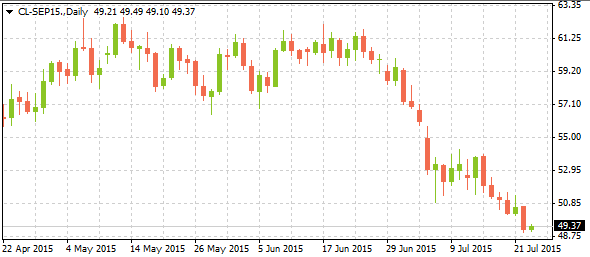The troubling EIA and API numbers released earlier this week confirm the oil patch is headed for another round of rough waters as the price breakout from a multi-month horizontal trend sees added directional momentum. The build in inventories related to the expectation of drawdowns shows that the supply glut in the United States has not abated despite a slight downtick in total production, which remains near cycle highs. Weakened demand for oil could be the beginning of much deeper problems for the US economy on the whole, as the vulnerability of the oil and gas sector drags on the broader economic fundamentals.
The rebound in oil prices following the last global financial crisis led to a boom in the oil and gas sector, buoyed in part by the US Federal Reserve operating at the zero-bound for interest rates. The exceedingly low rates led to excess investment-chasing after the newfound opportunities in the shale oil and gas sectors. Technological developments gradually reduced the breakeven point for many projects that took advantage of the shale formation, leading to a rapid resurgence in the American energy industry. Just years ago, the idea of energy security was a prevalent topic of discussion with many decrying the dependence on foreign oil imports. Now, inventories are facing the risk of overflowing supplies that could lead to a disastrous outcome for West Texas Intermediate pricing.

During the boom of the last five years, energy companies borrowed over $500 billion to fund investments in the sector, counting on the continuation of loose monetary policies and the hunt for yield to bolster growth opportunities while reducing borrowing costs. Now that the situation has reversed and prices are now half of where they stood just one year ago, the industry is having a serious reckoning with reality as many companies are forced to operate below breakeven prices. The extraction of shale oil and gas using horizontal fracturing techniques is much more costly compared to traditional oil wells. This is what necessitated the high levels of capital expenditures to fund the business, a situation that was only made possible through the proliferation of low interest rates.
Now that interest rates are set to rise and losses in the oil sector are mounting, there is high probability of a wave of defaults facing the industry. With many of the projects in question funded using high-yield debt and other costly instruments, there is a high risk of default and bankruptcy as many indebted firms struggle to cover costs as the major oil giants prepare defensive measures to weather the storm. The major problem is that the mounting losses for oil companies might not be contained to just the energy sector. The sheer size of the outstanding debt has the capability of crashing the high-yield bond market and triggering a wider credit event that extends to corporate debt. The credit cycle is likely to tip in the coming months as banks pullback on revolving credit facilities, meaning struggling companies are unable to obtain financing.

Ironically, late last year, the US Federal Reserve was under the impression that lower oil prices would provide an implicit stimulus for the American economy, from the perspective that consumers would find themselves with increasing disposable income as a result. The spending recovery from lower oil prices never materialized, as evidenced by the weak first quarter GDP print. Instead, Obamacare chipped away at the last remaining scraps of American’s disposable income, hurting the consumption recovery prospects and raising the possibility that the economy will reenter recession. The loss of high-paying jobs in the oil service industry, especially in the states benefiting most from the shale boom will likely weigh on the employment picture for months to come as layoffs escalate. However, the real concern from the drop in oil prices is what it signifies regarding the health of the broader economy.
Price deflation in commodities is especially worrisome as it indicates weakened trade flows and demand. Although the official statistics show the American economy has not yet entered a period of consumer price deflation, the fact that commodities are rapidly approaching the point at which extraction costs exceed market prices illustrates the potential for a wider recession and possibly even a depression. The confluence of factors driving oil prices lower at present are tantamount to a situation in which problems snowball quickly, creating an atmosphere of economic contagion. Even though oil prices seem localized in their impact, the wider implications should not go unnoticed. WTI crude oil cracking through $50 per barrel back to the downside should be treated as like a canary in the coalmine moment for the real economy, as policymakers struggle to avert another round of secular economic weakness.
